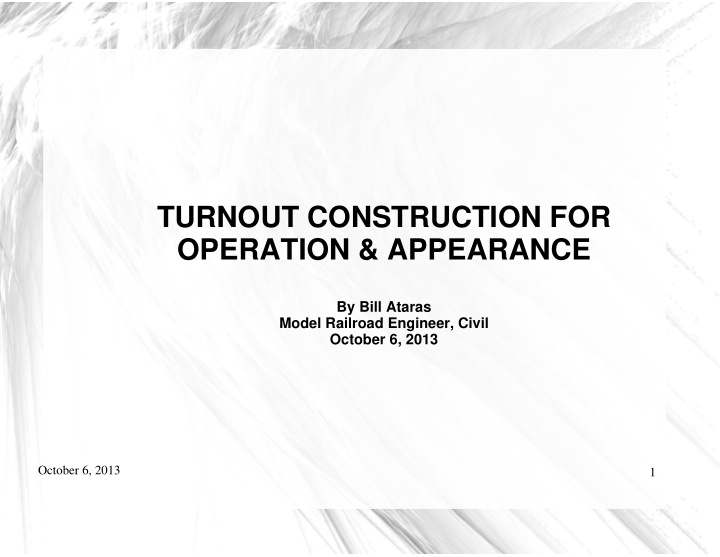



TURNOUT CONSTRUCTION FOR OPERATION & APPEARANCE By Bill Ataras Model Railroad Engineer, Civil October 6, 2013 October 6, 2013 1
Introduction Why build your own turnouts & special trackwork Important – REQUIRED - information What we will cover today What's included in the hand-out (CD) For more information October 6, 2013 2
Why Build Our Own Track Have track elements that aren't available “off the shelf” Model using prototypical rail sizes Have improved operational reliability Have improved electrical reliability Have the satisfaction of building something that looks great and works even better October 6, 2013 3
What is REQUIRED Here comes a shameless promotional message for the NMRA!! You need dimensions to build a car, engine or structure You also need dimensions to build trackwork (duh!) Standards These provide the dimensional data required to get all the pieces in the right positions S-3.1 Prototype & Fine Scale Track Standards S-3.2 Model Track Standards October 6, 2013 4
Topics to be Covered Here How to lay out a turnout How to make points and stock rails How to mate points and stock rails How to make a frog – EASILY! How to make wing rails and guard rails How to make a reliable, insulated throwbar October 6, 2013 5
Laying out Track Center Lines LAYING OUT THE CENTER LINES NUMBER 6 TURNOUT SHOWN SAME FOR ALL SCALES AND GAUGES 1.000" 6.000" FROG NUMBER POINT OF INTERSECTION OF CENTER LINES October 6, 2013 6
Laying out Turnout Ties NUMBER 6 HO STD GAUGE TURNOUT 6 .2 5 0 " DIM 8 LAST 16' SWITCH TIE 3 .9 0 6 " 2 .1 2 5 " DIM 24 DIM 2 0 .5 8 7 " 22" CENTERS 0 .2 5 3 " POINT OF HEEL OF FROG TIE POINT TIE HEAD BLOCK TIES ( 2 ) REMAINING SWITCH TIES ARE ON 20" CENTERS SWITCH TIES SHOWN ARE 16' X 8" WIDE STANDARD TIES SHOWN ARE 8.5' x 8" WIDE October 6, 2013 7
Preparing the Stock Rails CLEARANCE FOR POINT ALONG STOCK RAIL TOE OF POINT PLACEMENT OF SPIKE TABS PLACE TABS OVER TIES H OLE JUST CLEARS SPIKE SH ANK H EEL OF TOE OF POINT LINE POINT LINE October 6, 2013 8
Preparing the Point Rails FIRST STEP IN FOR MING A POINT RAIL 0.578" FILING LINE STEP 1 STEP 1 BEND LINE HEEL OF POINT AFTER FIR ST FILING STEP FILING LINE STEP 2 FILE DOWN AGAINST BASE, HEAD AND WEB AFTER SECOND FILING STEP FILING LINE FILE HEAD UP TO WEB STEP 3 AFTER THIRD FILING STEP FILING LINE STEP 4 TAPER WEB AND HEAD TO POINT AT TOP OF TOE October 6, 2013 9
Making the Point of the Frog AFTER BENDING TO FROG ANGLE STEP 1 FROG ANGLE STEP 1 BEFORE FILING FROG RAIL FILE LINE STEP 2 AFTER FILING FROG RAIL STEP 3 October 6, 2013 10
Making the Point of the Frog (2) BEND SIDES BACK TO FROG ANGLE STEP 4 STEP 1 AFTER BENDING FROG RAIL STEP 5 0.250" SOLDER TAB TO HOLD WING RAILS STEP 6 MAKE TAB FROM October 6, 2013 11 0.005" BRASS SHIM 0.092"
Preparing the Turnout Points PLEXIGLAS THROWBAR 0.063" THROWBAR INSTALLATION 0.085" 0.125" NORMAL TIES 1.932" 1.175" 8'6: or to suit 0.028" 0.125" 0.590" HOLE FOR 0.870" DRIVE WIRE 2 HEAD BLOCK TIES, 14' TIE END LINE HINGE PIN POINT TAB 0.210" 0.031" 0.018" 0.140" 0.060" 0.015" DIA. STEEL WIRE BRASS 0.015" THICK 2 REQUIRED October 6, 2013 12
Electrical Connections to Points Reliable operation requires dependable electrical connections to EVERY rail. A point touching a stock rail is a TERRIBLE electrical connection. Electrically and mechanically connect the point to the stock rail to the heel of the point. This guarantees that the point will be electrically connected – always! This requires the use of an insulating throwbar. I've tried various methods, but prefer the plexiglas bar shown here. For heavy rail, code 83 and up, the heel of the point is hinged. Use flat strip of 0.005” brass soldered over the gap between the point and closure rail. October 6, 2013 13
Preparing Guard Rails 11' HO GUARD RAIL 1.518" 0.400" 0.400" 1.000" POINT OF FROG LEFT OF THIS LINE DRAWN USING COD E 70 RAIL October 6, 2013 14
Guard Rail Design Notes Guard Rails are straight, not bent Bevel the flangeway side at each end to leave room for the wheel flange to enter the flangeway Most of the time, the base of the stock rail and guard rail will not be in contact. Remember, the flangeway is a relatively constant width; the base of the rails are wider for large code rail. Use thin brass tabs soldered to the bottoms of the stock rail and guard rail to set the correct position, or Use Pliobond to hold the guard rail in the correct position October 6, 2013 15
Summary There's only a few parts you need to make: Stock Rails Points Frog Guard Rails This will let you build ANY special trackwork!!! Expect to invest some trial and error time on your first couple of turnouts It's fun – and that's what model railroading is all about Have a few unique, 1 of a kind, trackwork scenes October 6, 2013 16
Recommend
More recommend